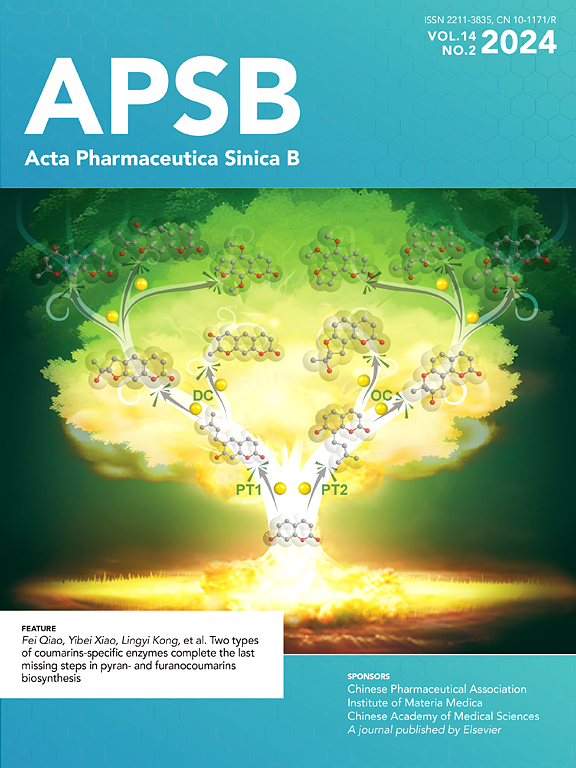Nose-to-brain delivery of targeted lipid nanoparticles as two-pronged β-amyloid nanoscavenger for Alzheimer's disease therapy
IF 14.6
1区 医学
Q1 PHARMACOLOGY & PHARMACY
引用次数: 0
Abstract
Alzheimer's disease (AD), characterized by β-amyloid (Aβ) aggregation and neuroinflammation, remains a formidable clinical challenge. Herein, we present an innovative nose-to-brain delivery platform utilizing lactoferrin (Lf)-functionalized lipid nanoparticles (LNPs) co-encapsulating α-mangostin (α-M) and β-site APP cleaving enzyme 1 (BACE1) siRNA (siB). This dual-modal therapeutic system synergistically combines the neuroprotective and microglia-reprogramming capabilities of α-M with the transcriptional silencing of BACE1 via siB, thereby simultaneously inhibiting Aβ production and enhancing its clearance. Fabricated via a microfluidic approach, the LNPs exhibited uniform particle size distribution, great encapsulation efficiency, and robust colloidal stability. Upon intranasal administration, Lf-functionalization enabled superior brain-targeting efficacy through receptor-mediated transcytosis. In vitro studies demonstrated that α-M reversed Aβ-induced low-density lipoprotein receptor downregulation, promoting microglial phagocytosis and autophagic degradation of Aβ, while siB effectively suppressed BACE1 expression, abrogating Aβ synthesis. In vivo investigations in APP/PS1 transgenic mice revealed remarkable cognitive recovery, substantial Aβ plaque reduction, and alleviation of neuroinflammation and oxidative stress. This intricately designed LNP system, exploiting a non-invasive and efficient nose-to-brain delivery route, provides a biocompatible, synergistic, and transformative therapeutic strategy for the multifaceted management of AD.

靶向脂质纳米颗粒作为双管齐下的β-淀粉样蛋白纳米清道夫用于阿尔茨海默病的治疗
阿尔茨海默病(AD)以β-淀粉样蛋白(a β)聚集和神经炎症为特征,仍然是一个艰巨的临床挑战。在此,我们提出了一个创新的鼻到脑递送平台,利用乳铁蛋白(Lf)功能化的脂质纳米颗粒(LNPs)共包封α-山竹苷(α-M)和β-位点APP切割酶1 (BACE1) siRNA (siB)。这种双模治疗系统将α-M的神经保护和小胶质细胞重编程能力与通过siB对BACE1的转录沉默协同结合,从而同时抑制Aβ的产生并增强其清除能力。通过微流控方法制备的LNPs具有均匀的粒径分布、良好的包封效率和良好的胶体稳定性。经鼻内给药后,lf功能化通过受体介导的胞吞作用实现了优越的脑靶向效果。体外研究表明,α-M可逆转Aβ诱导的低密度脂蛋白受体下调,促进小胶质细胞吞噬和Aβ的自噬降解,而siB可有效抑制BACE1的表达,抑制Aβ的合成。在APP/PS1转基因小鼠的体内研究显示,显著的认知恢复,大量的Aβ斑块减少,神经炎症和氧化应激减轻。这种设计复杂的LNP系统,利用非侵入性和高效的鼻子到大脑的输送途径,为AD的多方面管理提供了生物相容性,协同性和变革性的治疗策略。
本文章由计算机程序翻译,如有差异,请以英文原文为准。
求助全文
约1分钟内获得全文
求助全文
来源期刊

Acta Pharmaceutica Sinica. B
Pharmacology, Toxicology and Pharmaceutics-General Pharmacology, Toxicology and Pharmaceutics
CiteScore
22.40
自引率
5.50%
发文量
1051
审稿时长
19 weeks
期刊介绍:
The Journal of the Institute of Materia Medica, Chinese Academy of Medical Sciences, and the Chinese Pharmaceutical Association oversees the peer review process for Acta Pharmaceutica Sinica. B (APSB).
Published monthly in English, APSB is dedicated to disseminating significant original research articles, rapid communications, and high-quality reviews that highlight recent advances across various pharmaceutical sciences domains. These encompass pharmacology, pharmaceutics, medicinal chemistry, natural products, pharmacognosy, pharmaceutical analysis, and pharmacokinetics.
A part of the Acta Pharmaceutica Sinica series, established in 1953 and indexed in prominent databases like Chemical Abstracts, Index Medicus, SciFinder Scholar, Biological Abstracts, International Pharmaceutical Abstracts, Cambridge Scientific Abstracts, and Current Bibliography on Science and Technology, APSB is sponsored by the Institute of Materia Medica, Chinese Academy of Medical Sciences, and the Chinese Pharmaceutical Association. Its production and hosting are facilitated by Elsevier B.V. This collaborative effort ensures APSB's commitment to delivering valuable contributions to the pharmaceutical sciences community.
 求助内容:
求助内容: 应助结果提醒方式:
应助结果提醒方式:


